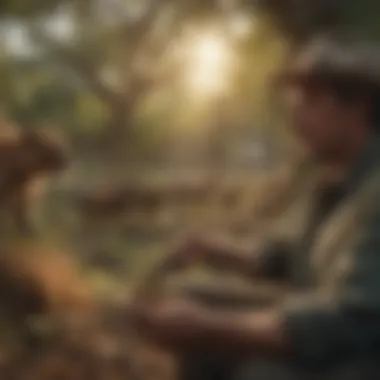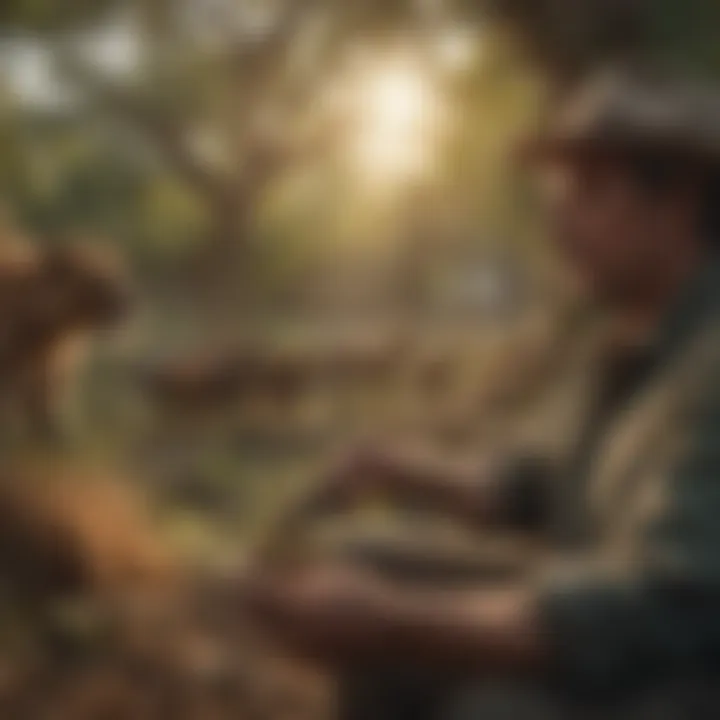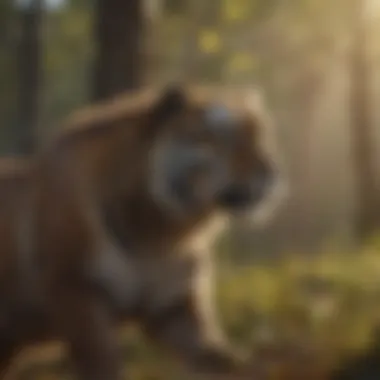Wildlife Protection: Strategies and Challenges


Intro
Wildlife protection has gained significant traction in recent years. The need for effective strategies to conserve biodiversity is more pressing than ever. Declining wildlife populations threaten ecosystems and human existence. This article covers the essential aspects of wildlife protection, focusing on strategies, challenges, and innovative solutions.
Key Concepts and Terminology
Basic Definitions
Understanding wildlife protection requires familiarity with some basic terms. Biodiversity refers to the variety of life on Earth, encompassing all species of animals, plants, fungi, and microorganisms. Conservation means the responsible management of natural resources to prevent depletion and extinction. Habitat is the natural environment where a species lives, plays a crucial role in the survival of wildlife.
Historical Context
The roots of wildlife protection can be traced back centuries. Early conservation efforts emerged in response to hunting pressures and habitat destruction. The establishment of national parks in the late 19th century marked a significant milestone in wildlife protection. However, as industrialization and urbanization progressed, conservationists faced increasingly complex challenges.
Recent Innovations and Trends
Technological Advancements
Recent advancements in technology play a pivotal role in wildlife conservation. For instance, satellite imagery allows conservationists to monitor land use changes in real-time. Drones are utilized for surveying large areas, making it easier to assess wildlife populations. Furthermore, data analytics enhance the effectiveness of conservation strategies by identifying trends and patterns.
Sustainable Practices
Sustainable practices are integral to wildlife protection. Organic farming reduces chemical use and promotes healthier habitats. Rotational grazing helps maintain grasslands, benefiting both livestock and wildlife. Community-based conservation initiatives enable local populations to manage and protect their environments actively.
Practical Applications and Techniques
Step-by-step Guides
- Assess the area: Understand the biodiversity present in the habitat.
- Engage the community: Work with local stakeholders to identify priorities.
- Implement sustainable practices: Use methods that support both agriculture and wildlife.
- Monitor progress: Regular reviews help in adapting strategies as needed.
Case Studies
One notable example of successful wildlife protection is the recovery of the California condor. Once on the brink of extinction, conservationists implemented a captive breeding program and habitat restoration efforts. Today, the population has increased significantly, illustrating the potential of collaborative strategies in conservation.
"Effective wildlife protection not only preserves nature but also ensures sustainable livelihoods for communities."
The journey of wildlife protection is ongoing and requires continuous commitment from individuals, communities, and governments alike. By understanding key concepts, embracing innovations, and applying practical techniques, stakeholders can contribute to the preservation of our planet's biodiversity.
Foreword to Wildlife Protection
Wildlife protection is increasingly vital because it addresses the urgent need to conserve the planet's biodiversity. The health of ecosystems is often measured by the diversity of species they host. When biodiversity thrives, ecosystems can function well, providing essential services like clean air, water, and food. However, ongoing threats to wildlife imply that current conservation practices need reevaluation and enhancement. In this context, understanding wildlife protection becomes imperative, especially for those engaged in agriculture and rural management.
The Significance of Biodiversity
Biodiversity refers to the variety of living organisms, including plants, animals, and microorganisms, along with the ecosystems they create. It is key to sustaining life, enabling food security by providing varied crops and livestock. Biodiversity also plays a significant role in expanding resilience against climate change. When ecosystems lose their diversity, they become more vulnerable to diseases and weather extremes.
- Diverse ecosystems can recover from disasters more effectively.
- Biodiversity drives ecosystem services that are crucial for agriculture.
Thus, a decline in biodiversity impairs not just wildlife but overall human prosperity. The importance of biodiversity cannot be overstated. It is a core element for conservation strategies aiming to safeguard the future of both wildlife and human communities.
Overview of Wildlife Threats
Wildlife currently faces numerous threats, which are exacerbated by human activities. Understanding these threats helps in forming effective strategies to mitigate them. The major threats to wildlife include:
- Habitat destruction: Urbanization, deforestation, and agricultural expansion destroy habitats, leading to species extinction.
- Poaching and illegal trade: Many species are driven to near extinction due to illegal hunting for ivory, skins, and other animal parts.
- Climate change: Fluctuating climates impact migrations, breeding, and food availability for many species.
- Pollution: Chemicals and waste can poison habitats, harming both wildlife and ecosystems.
Efforts to counter these threats are diverse and require global collaboration. It is through recognizing the extent of these threats that one can appreciate the necessity of effective wildlife protection measures.
Legislative Framework for Wildlife Protection
Understanding the legislative framework behind wildlife protection is crucial for anyone invested in conservation efforts. Laws and treaties provide the backbone for protecting endangered species and their habitats. They result from a shared acknowledgment that biodiversity is not just a luxury, but a necessity for ecological balance. Legal instruments establish guidelines and obligations for countries, organizations, and individuals alike. This framework plays a vital role in funding conservation initiatives, regulating land use, and preventing illegal activities like poaching.
International Treaties and Agreements
Numerous international treaties govern wildlife protection, each reflecting global consensus on the need for biodiversity conservation. Some well-known agreements include the Convention on International Trade in Endangered Species of Wild Fauna and Flora (CITES) and the Convention on Biological Diversity (CBD). CITES aims to ensure that international trade does not threaten species survival. Through a system of permits and regulations, it provides a structured approach to wildlife commerce. The CBD, on the other hand, emphasizes conservation, sustainable use, and equitable sharing of benefits derived from biological resources.
By participating in these treaties, nations express a commitment to collaborative efforts. Countries are encouraged to develop their own national laws that align with these international norms, thus contributing to a global vision of wildlife protection. The enforcement of these agreements can be a challenge, often hindered by limited resources or political will. However, they serve as essential tools for holding countries accountable in their conservation efforts.


National Laws and Policies
While international treaties set a broad framework, national laws and policies are where actionable measures take shape. Each country has its legal mechanisms designed to address local contexts and needs. These laws may include regulations on land use, hunting practices, and habitat protection. Countries may also establish national parks or protected areas through legislation, safeguarding critical habitats and landscapes.
For example, the Endangered Species Act in the United States offers a foundational approach. This act not only protects threatened species but also designates critical habitats essential for their survival. The effectiveness of such national laws often depends on public support, legislative backing, and adequate funding. Where laws are weak, species face higher risks of extinction due to habitat loss or inadequate protection.
Conservation Strategies
Conservation strategies play a vital role in wildlife protection by providing structured approaches to mitigate threats to biodiversity. These strategies encompass a wide range of practices aimed at conserving wildlife and their habitats. Successful conservation often requires integrating different methods while considering ecological, social, and economic factors. Understanding these strategies can help stakeholders prioritize actions that lead to effective conservation, ensuring that both wildlife and the needs of communities are balanced.
Protected Areas and Reserves
Protected areas and reserves are essential components of wildlife conservation. They serve as sanctuaries for endangered species and provide habitats that are critical for their survival. The designation of areas as protected helps limit human activities that can lead to habitat degradation. This includes logging, mining, and agricultural expansion.
These areas come in various forms, such as national parks, wildlife reserves, and marine protected areas. Each type of protected area has its specific management goals. For example, national parks typically focus on public enjoyment and recreation, while wildlife reserves are aimed primarily at conserving particular species and their habitats.
Effective management of protected areas involves ongoing research and monitoring. This ensures that the ecological health of the area is maintained and helps identify any potential threats to the wildlife within.
Wildlife Corridors and Connectivity
Wildlife corridors are crucial for maintaining biodiversity and facilitating animal movement between fragmented habitats. As human activity continues to encroach on natural landscapes, many species find their habitats split into isolated patches. This fragmentation can lead to reduced genetic diversity and increased risks of extinction.
By creating corridors, wildlife can move freely between isolated populations. This connectivity allows for foraging, mating, and migration, which are essential for species adaptability in changing environments.
Establishing these corridors often involves collaboration between various stakeholders, including government, private landowners, and local communities. Planning needs to consider the specific needs of the species in question, as well as the landscape features that will help them traverse successfully.
Captive Breeding and Reintroduction Programs
Captive breeding and reintroduction programs are vital strategies for recovering endangered species. These programs aim to breed individuals in controlled environments, followed by releasing them into their natural habitats. They help boost populations that have dwindled to unsafe levels.
Successful captive breeding requires comprehensive planning and execution. This involves ensuring genetic diversity in breeding populations and educating staff on species-specific care. It is also essential to prepare the habitat for the reintroduced animals. This may involve habitat restoration, creating protection plans, and ongoing monitoring once the species is reintroduced.
Overall, captive breeding can serve as a turning point for many species on the brink of extinction. However, it should be viewed as a temporary solution. Long-term success depends on addressing the root causes of population declines, such as habitat destruction and poaching.
By integrating these conservation strategies, efforts in wildlife protection can become more effective and sustainable. Understanding the individual components contributes to a holistic approach toward preserving wildlife and maintaining biodiversity.
Role of Technology in Wildlife Conservation
The integration of technology in wildlife conservation has become increasingly important in recent years. Technological advancements offer innovative solutions to combat threats against wildlife, such as poaching, habitat destruction, and climate change. These tools help conservationists gather data, monitor wildlife populations, and restore ecosystems. Understanding the role of technology in wildlife conservation illuminates its potential impact on preserving biodiversity for future generations.
Remote Sensing and Monitoring
Remote sensing technology utilizes satellites and aerial imagery to monitor wildlife habitats and human impact on the environment. This method allows for the collection of vast amounts of data over extensive areas. The benefits include the ability to track deforestation rates, changes in ecosystems, and monitor wildlife movement patterns.
For example, satellite imagery can reveal illegal logging activities in protected areas. This information is crucial for timely intervention by conservation authorities. Drones equipped with cameras provide high-resolution images and can access remote locations where traditional methods are not feasible. Remote sensing also enables real-time monitoring of wildlife populations, making it easier to assess their conservation status.
Key elements of remote sensing include:
- Scalability: Collect data across large landscapes without the need for extensive ground surveys.
- Precision: High-resolution images allow for detailed analysis of habitats and species interactions.
- Cost-Effectiveness: Reduces the costs associated with traditional survey methods.
By employing remote sensing technology, conservation organizations can make informed decisions. They can allocate resources more effectively and implement targeted measures to protect endangered species.
Data Analytics in Conservation Efforts
Data analytics plays a critical role in understanding trends in wildlife populations. By analyzing collected data, conservationists gain insights into species behavior, habitat use, and the overall health of ecosystems. Statistical models and algorithms assist in predicting future population trends and the potential effects of various conservation strategies.
The incorporation of big data analytics in wildlife conservation allows for better forecasting of challenges. It helps to identify areas at high risk due to climate change and human activities. Additionally, data analytics aids in evaluating the effectiveness of different conservation projects, ensuring that efforts are optimized for maximum impact.
Considerations when implementing data analytics in wildlife conservation include:
- Data Collection Methods: Ensuring data is collected objectively and from various sources.
- Collaborative Platforms: Sharing data among organizations enhances the understanding of wildlife dynamics.
- Continuous Improvement: Regularly updating analytics techniques and models to adapt to new findings.
Community Engagement and Education
Community engagement and education are vital components of wildlife conservation. This involvement fosters a sense of responsibility among local populations, ensuring sustainable practices that benefit both wildlife and communities. Engaging communities creates champions for conservation who can advocate for policies and practices that protect habitats and species.
One important aspect of community engagement is building local stewardship. When communities participate in conservation efforts, they take ownership of their environment. This can lead to improved management of natural resources and can mitigate issues like poaching and habitat destruction.


Building Local Stewardship
Local stewardship refers to the commitment of communities to manage their natural environment. It encourages people to recognize the intrinsic value of wildlife and ecosystems. For instance, communities involved in local conservation efforts often see positive impacts in biodiversity and ecosystem health.
In rural areas, local stewardship often includes sustainable agriculture practices, as farmers can work hand-in-hand with conservationists to create wildlife-friendly landscapes. By implementing techniques such as crop rotation and reduced pesticide use, farmers can support local wildlife and improve their own land's health.
"Empowering local communities is crucial for effective wildlife conservation, as they are often the first line of defense against habitat loss and wildlife exploitation."
Educational Initiatives in Schools and Communities
Educational initiatives play a key role in fostering awareness and understanding of wildlife issues. Programs in schools and communities can address the importance of biodiversity and stimulate interest among younger generations.
These initiatives can take several forms:
- Workshops and Training Sessions: These can equip community members with skills in wildlife monitoring and habitat restoration.
- Field Trips: Guided tours can teach participants about local ecosystems and species, fostering an appreciation for nature.
- Curriculum Integration: Schools can integrate conservation topics into their curriculums, encouraging students to think critically about their environment.
Through education, communities can also learn about the economic benefits of wildlife tourism. When locals understand that preserving wildlife can lead to increased tourism, they may be more likely to support conservation efforts.
Impact of Climate Change on Wildlife
The subject of climate change is increasingly vital in discussions about wildlife protection. As the planet warms, ecosystems are undergoing swift transformation. These changes not only affect wildlife but also challenge conservation efforts. It is clear that climate change plays a significant role in habitat alteration and species survival. Understanding its impact fosters more effective strategies for wildlife conservation.
Shifts in Habitats and Species Distribution
Climate change prompts alterations in habitats, leading to shifts in species distribution. Many species are migrating to cooler areas, often toward the poles or higher elevations. This movement disrupts established ecosystems and can result in heightened competition between native and invading species. For example, the red fox has expanded its range into areas previously dominated by the arctic fox due to changing temperature patterns.
As habitats change, the animals that can't adapt or migrate may face extinction. A few factors contribute to this crisis. First, habitat loss limits the available space for many species. In addition, fragmentation of habitats from human activities exacerbates the challenges of migration.
"If some species are not able to follow their shifting habitat, they will dwindle and possibly vanish."
Effective conservation strategies must involve understanding these shifts. Protected areas should be assessed and adjusted to accommodate species on the move. Furthermore, engaging local communities in monitoring these changes can provide valuable data for conservationists.
Effects of Extreme Weather Events
Extreme weather events linked to climate change impose another layer of threat to wildlife. Increasing temperatures contribute to more frequent and severe droughts, floods, and storms. These events destroy habitats and disrupt food supply chains.
Wildlife may face direct physical threats from these occurrences. For example, drought conditions paired with wildfires lead to habitat loss for many species. Flooding can displace animals from their natural environments, causing population declines.
Long-term forecasts indicate that specific species are more vulnerable than others. Tidal wetlands and coastal habitats experience the brunt of rising sea levels and storms, putting species such as the salt marsh bird at risk.
To adapt, conservation measures must consider these extreme weather impacts. This includes implementing adaptive management practices that respond to changing environmental conditions.
In summary, climate change poses significant challenges for wildlife and conservation strategies. A clear comprehension of habitat shifts and the consequences of extreme weather events is crucial for effective decision-making in wildlife protection.
Challenges in Wildlife Protection
The topic of challenges in wildlife protection is crucial for understanding the broader context of conservation efforts. Wildlife is under constant threat due to various human activities. Recognizing these challenges helps in formulating effective strategies to mitigate them. Tackling issues such as poaching and illegal wildlife trade, along with habitat destruction, is vital for ensuring sustainable ecosystems. Without addressing these challenges, conservation initiatives may fail to achieve their intended impact.
Poaching and Illegal Wildlife Trade
Poaching involves the illegal hunting and capturing of wild animals. This activity significantly contributes to the decline of many species. The illegal wildlife trade is a multi-billion dollar industry that supplies demand for products such as ivory, fur, and exotic pets. With the rise of globalization, poachers can access more remote locations, posing greater threats to wildlife.
Impact of Poaching:
- Species extinction rates have increased due to targeted poaching.
- Disruption of ecological balance as predator and prey populations are altered.
- Loss of genetic diversity, making species more vulnerable to diseases.
Efforts to combat poaching require robust law enforcement and strong legislative frameworks. Community involvement is also essential. Many local populations depend on wildlife for their livelihoods, and educating them about sustainable practices can reduce reliance on poaching.
"The battle against poaching is as much about people as it is about wildlife. Reducing poverty and providing alternative livelihoods is key to success."
Habitat Destruction and Fragmentation
Habitat destruction is primarily driven by agricultural expansion, urban development, and logging. As habitats shrink, wildlife populations find it increasingly challenging to survive. Fragmentation leads to isolated populations that cannot interbreed, further threatening their viability.
Consequences of Habitat Destruction:
- Loss of food and shelter for many species.
- Increased human-wildlife conflict as animals venture into urban areas.
- Reduction in biodiversity, affecting ecosystem functions.


To address habitat destruction, conservationists advocate for sustainable land-use practices. Integrating wildlife corridors can help connect fragmented habitats, allowing species to move freely. Additionally, restoring degraded habitats can facilitate recovery.
Successful Case Studies in Wildlife Conservation
Successful case studies in wildlife conservation serve as essential pillars in the broader narrative of environmental protection. These examples provide insights into effective strategies that have led to tangible results, showcasing the potential for restoration and balance within ecosystems. Understanding these cases deepens the knowledge of what can be achieved through dedicated efforts and multifaceted approaches to wildlife preservation. The following sections will explore two significant elements: the reintroduction of endangered species and community-driven conservation projects.
Reintroduction of Endangered Species
The reintroduction of endangered species has proven to be a highly impactful conservation strategy. This process involves returning species that have been extirpated or are critically endangered within a specific region. One noteworthy example is the California condor, which faced near extinction due to habitat loss and lead poisoning. Conservation efforts included captive breeding, habitat restoration, and strict regulations against lead ammunition. Now, the populations of California condors are slowly increasing, demonstrating the potential success of these programs.
Reintroduction programs often require comprehensive planning and execution, addressing the various factors that led to the original decline of the species. Key considerations in these efforts include:
- Habitat suitability: Identifying and restoring the ecological environments necessary for the species’ survival.
- Genetic diversity: Ensuring that captive breeding programs maintain a diverse gene pool to promote healthy populations upon reintroduction.
- Community involvement: Engaging local communities to foster a sense of stewardship towards their environment and the species involved.
The success of reintroduction projects not only aids in the recovery of species but also contributes positively to biodiversity as a whole. When a species thrives, it typically results in a more balanced ecosystem, benefitting other flora and fauna.
Community-Driven Conservation Projects
Community-driven conservation projects emphasize the role of local populations in preserving wildlife and habitats. These initiatives often derive success from the belief that local people are in the best position to manage and protect their ecosystems. A prime example can be observed in the Borneo rainforest, where indigenous groups have partnered with conservation organizations to create sustainable land-use practices that protect endangered species, like the Sumatran orangutan.
Key features of community-driven projects typically include:
- Local knowledge integration: Utilizing the traditional expertise that local communities have about their habitat fosters better conservation practices.
- Economic alternatives: Providing viable economic opportunities that reduce reliance on destructive practices, such as logging or poaching.
- Education and awareness: Raising awareness through educational programs that highlight the importance of biodiversity and the roles individuals can play in preserving it.
Such community-based efforts often lead to stronger protections for wildlife as they align conservation goals with the economic and social aspirations of local populations. By securing livelihoods while simultaneously conserving wildlife, these projects create a sustainable model for long-term success in biodiversity preservation.
"Community involvement is crucial. When people feel responsible and see direct benefits, they are more likely to protect their environment."
Future Directions in Wildlife Protection
The continual decline in wildlife populations demands innovative strategies and reformed approaches to conservation. In this section, the discussion on Future Directions in Wildlife Protection aims to shed light on emerging methodologies and collaborations that can enhance the effectiveness of conservation efforts. As challenges evolve, so must the tactics we employ to preserve biodiversity and protect endangered species. The focus will be on innovative funding models and the essential role of global collaboration.
Innovative Funding Models
Sustainable financing is crucial for long-term conservation initiatives. Traditional funding sources often fall short in addressing the needs of projects. Innovative funding models can transform the landscape of wildlife protection by diversifying sources of financial support.
Here are some examples of innovative funding approaches:
- Conservation Trust Funds: These funds provide a stable source of financing for conservation projects. They ensure that vital resources are available over an extended period.
- Payment for Ecosystem Services (PES): This model compensates landowners for maintaining ecosystems that provide services like clean water, carbon sequestration, and biodiversity. It creates a direct financial incentive for conservation actions.
- Eco-tourism: Responsible eco-tourism generates revenue that can be reinvested into local conservation efforts and community development. Promoting natural environments attracts visitors while supporting wildlife protection.
- Crowdfunding Platforms: Online crowdfunding facilitates raising small amounts of money from numerous individuals. This can engage the general public in wildlife conservation, enhancing community investment in protection efforts.
Implementing these models requires careful planning and stakeholder engagement. It is crucial to ensure that local communities benefit from these initiatives, enabling them to play an active role in conservation.
The Role of Global Collaboration
Wildlife protection and biodiversity conservation cannot be confined to national borders. Global collaboration is a key factor in tackling transboundary wildlife issues effectively.
A cooperative approach can yield several benefits:
- Shared Resources and Knowledge: Countries can learn from each other’s successes and failures. Shared intelligence allows for the quick adaptation of strategies that are effective in different contexts.
- Joint Conservation Efforts: Collaborative projects can address species that migrate across borders, ensuring consistent protection measures are enforced.
- Fundraising Opportunities: Global coalitions can attract international funding sources that individual countries may struggle to access.
- Public Awareness Campaigns: Partnering with international organizations like the World Wildlife Fund can amplify conservation messages, increasing public awareness and engagement across nations.
"Collaborating on conservation efforts reflects our interconnectedness in the face of biodiversity loss. Each nation has a role to play in protecting wildlife globally."
In summary, the Future Directions in Wildlife Protection hinge on adopting innovative funding mechanisms and forging strong global partnerships. As we confront the alarming threats to biodiversity, these future strategies will be essential for generating the needed resources and cooperation to safeguard wildlife for future generations.
Epilogue
The conclusion of this article serves as a vital synthesis of ideas, underscoring the necessity of wildlife protection. In an era where biodiversity is under severe threat, the discourse on conservation has never been more relevant. This section pulls together the several strategies and successful case studies discussed throughout the text, reiterating the importance of collaborative efforts and community involvement.
Summarizing Key Points
The exploration of wildlife protection has covered several key areas:
- Legislative Framework: Both international and national laws form the backbone of conservation efforts, ensuring a protected status for endangered species and their habitats.
- Conservation Strategies: Methodologies such as establishing protected areas, creating wildlife corridors, and implementing captive breeding programs are significant in preserving species.
- Role of Technology: Advancements in remote sensing and data analytics have transformed monitoring efforts to increase efficiency and effectiveness in conservation initiatives.
- Community Engagement: Building local stewardship and promoting educational initiatives demonstrate the need for grassroots involvement in wildlife protection efforts.
- Challenges We Face: The persistent threats from poaching and habitat destruction highlight the urgent need for continuous advocacy and action in conservation.
Each of these points showcases a piece of the broader puzzle in wildlife conservation, suggesting that a holistic approach is essential for sustained success.
Call to Action for Wildlife Conservation
To truly engage in wildlife conservation, every individual can make an impact. Here are several actionable steps that can be embraced:
- Advocate for Stronger Policies: Reach out to local representatives to support legislation aimed at wildlife protection. Awareness results in improved policies.
- Participate in Conservation Programs: Join local initiatives that focus on habitat restoration or support national parks and reserves.
- Educate Others: Share knowledge about the importance of biodiversity and the specific threats animals face. Education can mobilize communities toward conservation goals.
- Reduce Footprint: Being mindful of consumption choices can lessen our impact on wildlife. Sustainable practices in agriculture and daily living are crucial.
Engaging in these actions can foster a more protective environment for wildlife. An ongoing commitment from all levels of society is necessary to secure the future of biodiversity. Conclusively, the fight for wildlife protection is not merely for animals, but for the ecological balance that sustains all life on Earth. The work begins individually yet can flourish through collective efforts.















